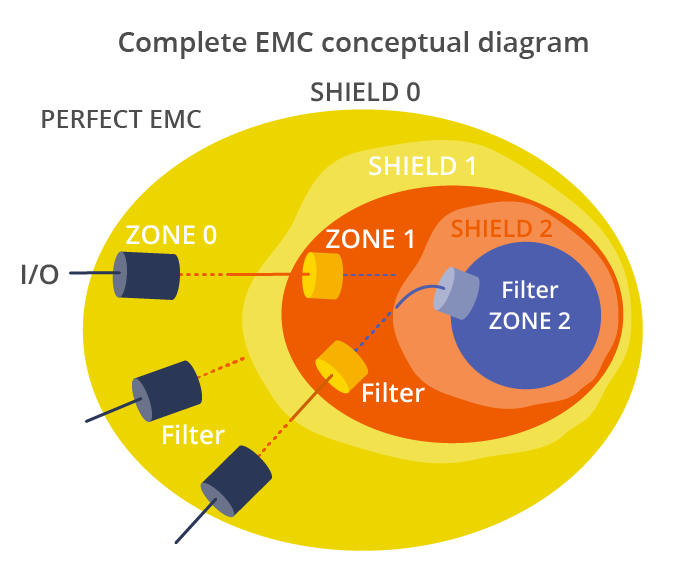Intro to EMC Topics
Practical Applications—Part 3: Noise Problems in Smartphones as They Become More Multifunctional

5G communication, which has entered service worldwide from around 2020, is a next-generation communication network technology featuring high-speed, large-capacity transmissions tens to hundreds of times faster than 4G, real-time performance (low latency), and the simultaneous connection of an extremely large number of nodes. As part of the base infrastructure for an advanced stage of human society known as “Society 5.0” or ”Industry 4.0,” 5G is expected to revolutionize our daily lives, businesses, motorization and medical care, as well as the way we work.
- Noise suppression components for ultra-high-speed, large capacity 5G communication

- Autointoxication—a device’s own generated noise radiating back through its built-in antenna

- Why common mode filters are indispensable to digital devices

- Serial differential transmission, which enables high-speed data transmission, has its own problem

- Common-mode filters based on advanced thin-film process technologies

- Summary of countermeasures against autointoxication in smartphones

Noise suppression components for ultra-high-speed, large capacity 5G communication
The 5G society is an advanced communication network connected to AI (artificial intelligence) and a vast number of IoT devices. Smartphones and wearable devices are points of contact between the network and people, and are expected to evolve even further. Because 5G communication involves ultra-high-speed and large-capacity signals, smartphones and wearable devices—which are the entry and exit points of information—need to be protected from noise more than ever before.
Generally, the first option for noise suppression in an electronic device is the LC filter, which combines an inductor (coil/L) and a capacitor (C). There are three types of LC filters: LPF (Low-Pass Filters), HPF (High-Pass Filters) and BPF (Band-Pass Filters).
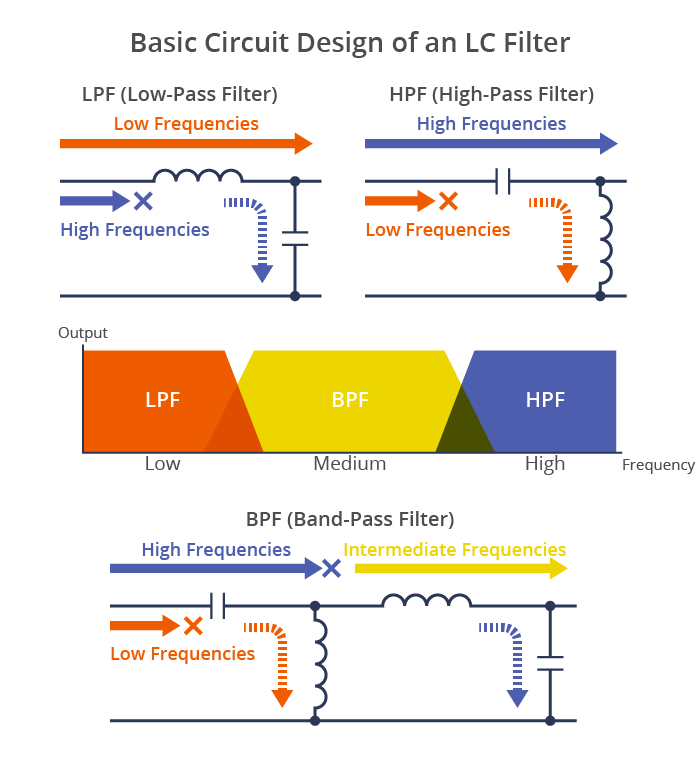
Pulse-shaped digital signals in data communication are a collection of the fundamental wave and its integer multiple harmonics, of which the higher harmonic components tend to become radiated noise. Single-chip LPFs designed to remove unwanted harmonic components are called EMI filters.
However, EMI filters are inadequate noise countermeasures for connections inside smartphones (between the display or built-in camera and the CPU, etc.), where high-speed, large-capacity data transmission is required, and for interfaces to external devices (digital cameras, projectors, 4K TVs, etc.). This is why there has been a growing need for better alternatives.
Chip beads leverage the characteristics of ferrite and remove high-frequency noise effectively, but they have the drawback of distorting the signal waveform. TDK has created noise suppression filters* that overcome this problem. For suppressing radiated noise, Flexield—a flexible noise suppression material in sheet form—is also effective.
*Noise suppression filter: A noise countermeasure component that delivers both strong noise suppression and signal quality preservation through advanced ferrite technology and internal structure design. They are typically used in audio lines of smartphones.
*A flexible electromagnetic shield made of soft magnetic material and resin. It suppresses radiated noise from electronic devices across a wide range of frequencies.
Because common mode noise is a major source of radiated noise, it is extremely important to suppress it at the source and prevent it from being conducted to other circuits or external devices. Since the 1990s, the common mode filter has become an invaluable noise countermeasure component in electronic devices.
From here on, we will discuss noise problems in smartphones, which are becoming increasingly multifunctional.
Autointoxication—a device’s own generated noise radiating back through its built-in antenna
Smartphones are multimedia terminals that have evolved through the fusion of mobile communication and personal computer technologies. They are highly advanced wireless communication devices, constantly connected to networks. The internal circuitry and layout of components/modules vary between manufacturers and models, but the basic configuration of a smartphone is as follows.
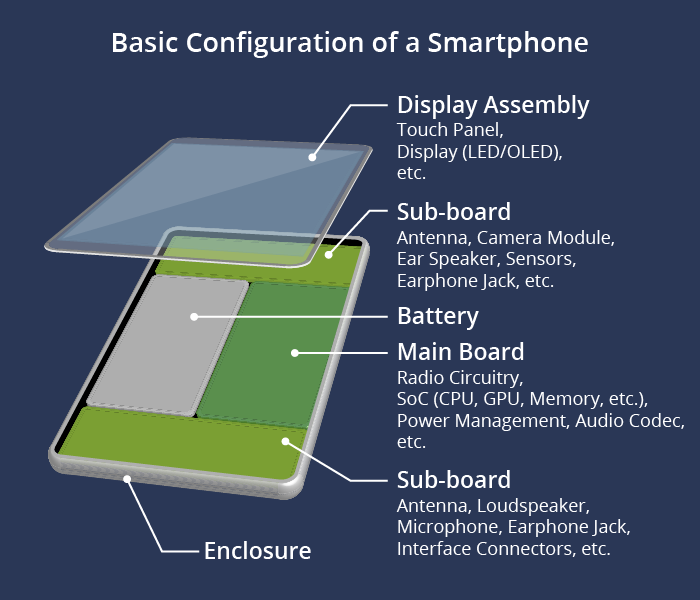
Antennas, speakers, microphones, camera modules, interface ports, etc., are mounted on sub-boards near the top and bottom of the device and close to one another, due to the increased density of circuits. This is one of the factors contributing to autointoxication.
A smartphone that is powered on is constantly sending and receiving signals to and from cell towers, even during standby, to exchange location information and be ready to take or make calls. The antennas are always listening closely to discern the pertinent signals from among the multitude of radio waves coming from cell towers. If the built-in antennas pick up noise radiated from the phone’s own internal digital circuitry, it can degrade call quality or the display’s image quality. This is a noise problem known as autointoxication* in smartphones.
*Autointoxication is originally a medical term that refers to the process by which a substance that is normally harmless turns toxic within the body, resulting in poisoning. In electronic devices, even if conducted and radiated noise from the outside are completely shut out, noise generated from within the internal circuitry can adversely impact the device’s performance.
Smartphones are advanced wireless communication devices that house not only cellular antennas (for 5G/4G/W-CDMA/GSM, etc.) but numerous other antennas for uses like Wi-Fi, Bluetooth, NFC, 1seg, and RFID. Rod antennas were used in early mobile phones, but smartphones, which are far more multifunctional but cramped inside, employ trace pattern antennas and miniature chip antennas.
Increased circuit density and functionality have forced these antennas to be mounted in close proximity to high-frequency transceiver circuits and analog/digital audio circuits for speakers and microphones.
What’s worse, interface cables connecting smartphones to external devices such as digital cameras, projectors and 4K TVs behave like antennas, radiating noise and causing autointoxication. In other words, as smartphones become more multifunctional, the problem of autointoxication intensifies.
Listed below are common examples of autointoxication in smartphones and their countermeasures.
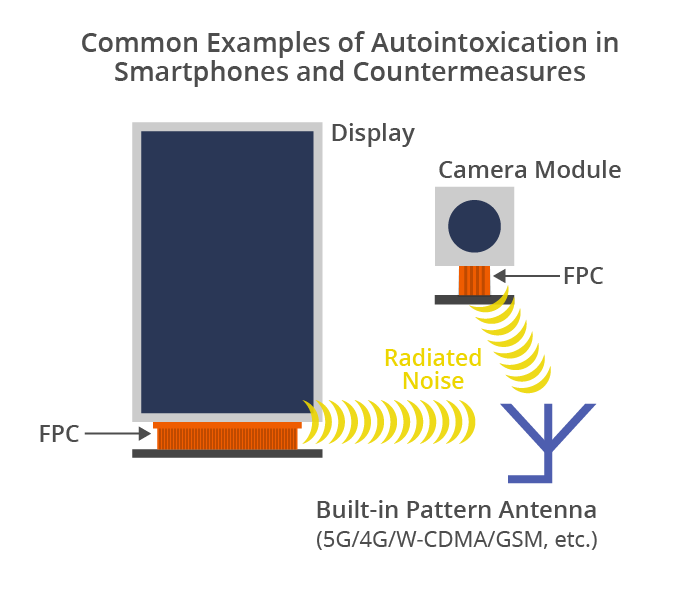
Example 1: Noise radiating from FPCs (flexible printed circuits) connecting camera modules and displays is interfering with adjacent built-in antennas, degrading communication quality.
Noise Countermeasure: Insert a common-mode filter. Apply Flexield (a noise suppression covering) to the PFC.
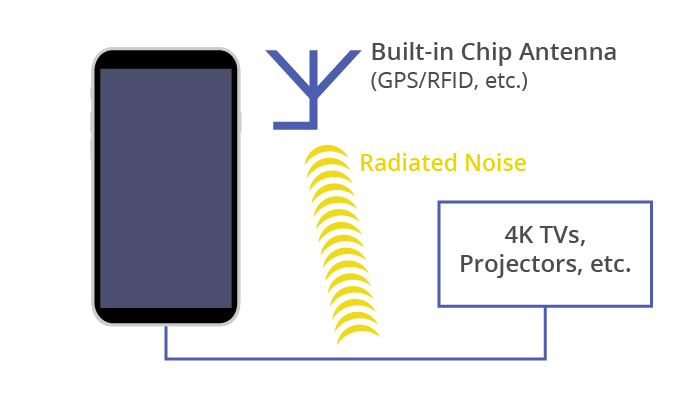
Example 2: Noise radiating from cables (USB-C cables, etc.) connecting smartphones to 4K TVs, projectors, etc., is interfering with built-in antennas, degrading communication quality.
Noise Countermeasure: Insert common mode filters at the interface ports.
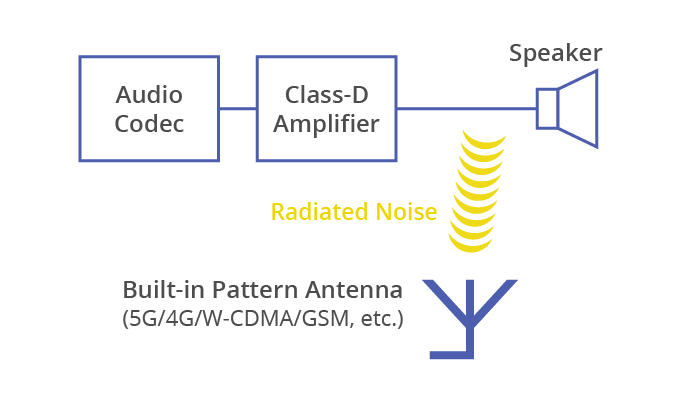
Example 3: Noise radiating from audio lines connecting the class-D amplifier (a filterless audio amplifier) and the speaker is interfering with adjacent built-in antennas, degrading communication quality.
Noise Countermeasure: Insert common mode filters in the speaker lines, etc.
Why common mode filters are indispensable to digital devices
Common mode filters are widely used in smartphones and other digital devices that transmit data at high speeds, because they are very adept at suppressing only common mode noise without affecting signals.
The basic structure of a common mode filter is a ring-shaped ferrite core with two wires wound in the same direction. Because signals travel outbound through one wire and return through the other, they are in differential mode, and the magnetic fluxes generated by the coils cancel each other out. For this reason, the use of a common mode filter has virtually no effect on ultra-high-speed signal waveforms reaching as fast as 10Gbps.
Conversely, since common mode noise flows in the same direction through the two wires, the magnetic fluxes generated by the coils are compounded.This increases inductance, which in turn increases impedance, reflecting the incoming noise and preventing it from propagating. That is the basic principle of noise suppression by a common mode filter.
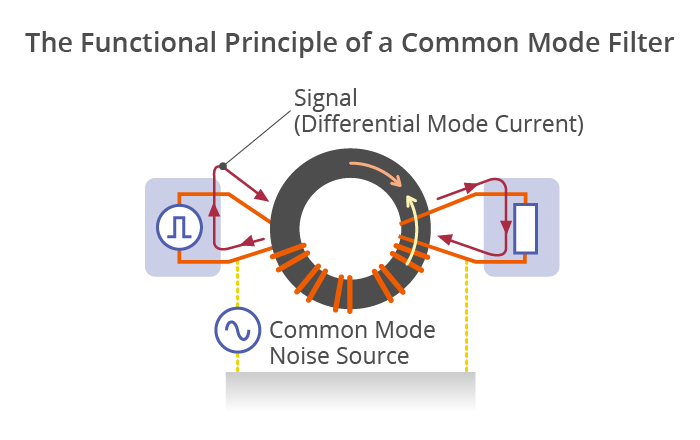
The signal current travels outbound through one wire and returns through the other (differential mode), which cancels out the magnetic fluxes generated in the coil. Therefore, it has little effect on the signal’s waveform.
Serial differential transmission, which enables high-speed data transmission, has its own problem
Because electronic devices require high-speed, large-capacity data transmission through their interfaces, a method known as serial differential transmission is used. This is a method of sequentially transmitting differential signals whose phases are flipped 180 degrees and sent over two wires. It has the advantages of greatly reducing the number of signal lines compared to parallel transmission and the ability to support higher speeds.
The following are some of the common high-speed interface standards based on serial differential transmission that are found on smartphones.
• Internal interfaces (for connections to displays, camera modules, etc.): MIPI, LVDS
• External interfaces (for connections to cameras, projectors, 4K TVs, etc.): USB, HDMI
While serial differential transmission is characterized by its low susceptibility to external noise, in practice, it does suffer from the problem of generating common mode noise, stemming from slight deviations in the differential signals’ phases (known as skew) and irregularly timed rises and falls in the signals waveform.
In past articles (Components—Part 5, for example), we mentioned that high-speed digital interface cables (USB, HDMI, etc.)—based on differential transmission methods and used to connect PCs and peripheral devices—can become sources of common-mode noise. For example, FPCs (flexible printed circuit boards) that connect the display and camera modules to the CPU as well as audio lines that connect class-D amplifiers to speakers are sources of common mode noise that lead to autointoxication.
Common mode filters are becoming more important for smartphones and wearable devices in the coming 5G era, where transmission speeds can reach tens of gigabits per second, thanks to higher clock speeds and parallel connection lanes. Common mode filters are noise suppression components capable of handling these extreme 5G-class speeds.
Common-mode filters based on advanced thin-film process technologies
Thin-film common mode filters are available in ring-shaped ferrite core types, miniature SMD (surface mount device) types that combine drum and plate cores, as well as types where two thin-film coils oppose each other.
TDK’s thin-film common mode filters expand upon advanced thin-film process technologies cultivated through the development and production of HDD heads and other fields. Thin-film, high-magnetic-flux-density ferrite material and thin-film coils shaped in high-precision patterns are fused in layers. These cutting-edge components will enable noise suppression in smartphones and tablet devices in the 5G era and contribute to further miniaturization and wider functionality.
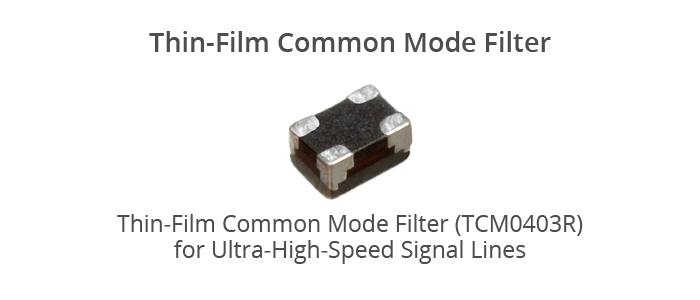
Based on advanced thin-film process technologies matured through the development and production of HDD heads and other fields.
A common mode filter that combines high-magnetic-flux-density ferrite substrates and thin-film coils in high-precision patterns.
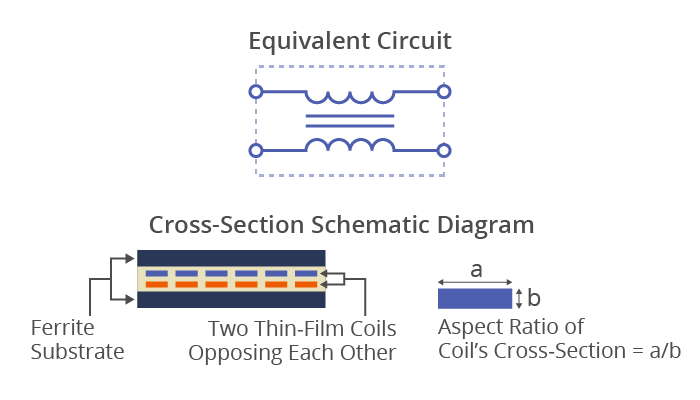
The aspect ratio of the coil’s cross-section has been raised to more than 2, achieving industry-leading miniaturization and low stray capacitance.
Summary of countermeasures against autointoxication in smartphones
As smartphones become more multifunctional, the problem of autointoxication worsens. This is due to noises that radiate from transmission lines within the device and from cables connecting the smartphone to external devices.
Below are some of the basic countermeasures.
• Begin by using component layouts, transmission line designs, ground designs and shielding that are less susceptible to noise. In smartphones, however, placing noise sources and built-in antennas close to one another may be unavoidable due to increased circuit densities. Particularly, antennas tend to be concentrated at the top and bottom of the enclosure, along with camera modules, microphones, speakers, and other components.
• Therefore, it is important to select and use appropriate noise suppression components for smartphones, which are becoming increasingly multifunctional. Common mode filters and noise suppression filters are effective, as well as the use of noise suppression sheets (Flexield).
• Impedance mismatches in transmission lines can reflect and radiate noise, leading to autointoxication. When choosing a common mode filter, carefully consider noise attenuation characteristics (insertion attenuation-frequency characteristics) and appropriate impedance matching.
TDK is a comprehensive electronic components manufacturer leading the world in magnetic technology



